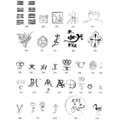Porcelain brand
A porcelain brand (also ceramic brand, trademark or floor brand) is a trademark protected by trademark law. This identifies the manufacturer concerned and is usually applied to the underside of porcelain and ceramics . Trademarks are unique and therefore different from other signs.
history
Brand references in the form of special characters can already be found under Roman ceramics and under early Chinese porcelain . In Europe, however, the actual marking only began with the introduction of porcelain, i.e. from around 1720. In the following 90 years, i.e. until around 1810, the blue marks were applied by hand with a brush, mostly under the glaze . From 1810 rubber stamps were also used, often in green, as these were a little easier to stamp because of their thinness. At the end of the 19th century it became customary to add decor names to the actual factory mark. An important dating limit is given by the introduction of the British Trademark Act of 1887: According to this, the country of origin had to be stated on all imported goods; on German porcelain, this usually happened with the stamp “ Made in Germany ” or just with “Germany”. Porcelains showing this additional stamp come from a production after 1887.
In 1874 the “Law on Trademark Protection” was passed in Germany. From this point on, research into the brands was made much easier.
Trademark
A distinction must be made between the characters on porcelain or ceramic:
- Factory brand : It designates the manufacturer and represents the actual porcelain or ceramic brand. This may have often been forged.
- Trademark : It designates a customer, distributor, dealer or similar
- Property marking: An additional marking such as that of a princely house, the air force, hotel chains or other owners.
-
Painter's mark : For hand-painted pieces, it is a mark of the respective porcelain painter in the form of a
- full name
- Painter's monogram
- Numbers for internal purposes, often in red or gold, mostly for piece counting, remuneration or similar reasons.
- Designer name : Is a signature of the respective designer of the respective porcelain series or a single piece.
- Bossierernames
- Mold number / model number : A special number, sometimes with a size indicator, for pieces poured into the mold.
- Decor designation : A special designation when different decorations (decors) have been applied to the same basic shape .
- Size number : A special number when a shape has been put on the market in different sizes.
- Quality mark: A special mark to identify a quality level such as 2nd choice.
- References to property rights : With imprints such as "Legally protected", "Deposeé", "D. R. P. ”/“ DBP ”(German imperial or federal patent) or“ DBP pending ”(patent pending).
Brand types
Underglaze marks
- Incised mark: The mark is carved into the still soft mass with a stylus.
- Press mark: The mark is pressed into the still soft mass with an embossing stamp.
- Brush mark: The mark is painted on with a brush and paint after the first firing.
- Stamp mark: The mark is stamped on with a color stamp before the glaze firing.
- Decal: A decal for marking porcelain is mainly used for complex trademarks and large series.
Underglaze marks are usually of blue, black or green underglaze color .
Overglaze marks
- Brush mark: With the help of a brush, the mark is painted on after the glaze firing.
- Stamp mark: The mark is stamped on with a stamp after the glaze firing.
- Decal: see underglaze marks
Overglaze marks are usually applied in overglaze colors , which contrast well with the background. They can also be made of bright gold and very rarely in polished gold .
Floor brands from major German manufacturers
Meissen porcelain company logo , 1710
Porcelain brand of the Königliche Porzellan-Manufaktur Berlin
Porcelain brand from the Höchst Porcelain Manufactory
Floor mark Wallendorfer Porzellan , from 1964
Old Rosenthal company logo , approx. 1900
Arzberg , 1950s and 1960s
Sorau , C. & E. Carstens around 1930
Floor brands from other manufacturers
Wallendorfer porcelain , Lichte / Thuringia
Spode, Stoke-on-Trent
Spode, Stoke-on-Trent
Carl Tielsch , Altwasser
Trademark counterfeiting
Brand counterfeits and imitations came up very early on, with the popular and therefore mostly expensive porcelains in particular being counterfeited. For example, the brands Meißener Porzellan , Manufacture royale de porcelaine de Sèvres and Capo-di-Monte . Today cheap porcelain are mainly from Asia as a "gift goods" imported and with imagination brands provided offered on antique markets as "collectibles". Counterfeit copies are then increasingly being replaced by “style falsifications”.
Web links
- Compilation of the most famous floor brands from porcelain companies and manufacturers along the Porzellanstraße
- Directory of freely accessible pages on porcelain and ceramic brands with images
- Online lexicon for determining porcelain brands
- Determination of porcelain and ceramic brands
- Assignment of porcelain brands (English)
- Marks on Fürstenberg porcelain from the 18th century
- "Guide To Pottery & Porcelain Marks" (porcelain brands Europe, Russia, China, Japan, USA etc.)
















